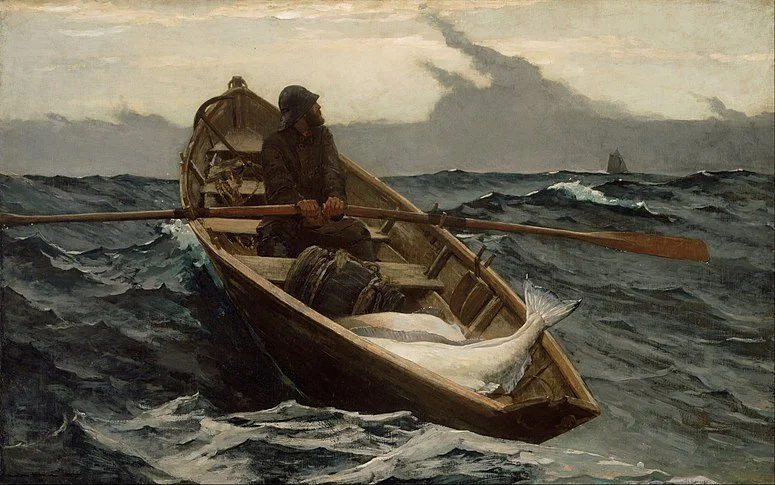Finding their way through low visibility
“The Fog Warning” (1885), by Winslow Homer (1836-1910).
Adapted from Robert Whitcomb’s “Digital Diary,’’ in GoLocal24.com
The beauty and increasingly complicated society of the Maine Coast sure have long lured novelists. The latest of note is Caleb Mason’s Thickafog (a lobsterman expression), a mystery set on an island based on Vinalhaven, which these days is mostly known for summer people and what remains the Pine Tree State’s most famous fishery — lobsters (though warming seas are tending to move more and more of them toward Canada). Oyster, seaweed and other aquaculture will play a bigger and bigger role.
Fog, of course, is often on, or lurking just off, The Pine Tree State’s storied coast, making scenic views more unpredictable than in most beautiful places.
And there’s the psychological and emotional fog that comes and goes in this tale centered on the deadly fall off a cliff of Bobby, a charming (maybe too charming?) elderly man. Jon, his alcoholic, intense, often bitter, but still usually functioning, son, becomes a suspect in the death. He’s a carpenter on the island, where work on new and old summer places provides a lot of local income. Then there’s Ingrid, an increasingly demented but still elegant lady nicknamed “The Island Queen,’’ who becomes the romantic focus of Bobby, causing conflict in her family.
As in any good novel, events change leading characters in the book in strong or subtle ways.
Unlike many novels set on the Maine Coast that tend to be mostly about affluent, or at least formerly affluent, summer people with fancy educations, Thickafog’s characters include a range of year-round locals with individual family troubles and joys.
Challenges include drug addiction, crime, teenage angst, isolation-spawned anxiety/depression, poverty, material shortages, medical emergencies, rigorous weather, and you’d think, a touch of claustrophobia, especially in the winter.
And yet the islanders, year-round or just summer folks, and of all financial classes and other backgrounds, have a way of coming together when needed: The novel displays the island’s rough-hewn sense of community and the ironical humor that helps support it. And all this happens amidst the island’s vividly described seasonal changes, from temperate if sometimes low-visibility summers to cold stormy winters.
Vinalhaven, as was nearby Stonington, was famous for its beautiful granite. This 1904 postcard shows columns being prepared for New York City’s Cathedral of St. John the Divine.

